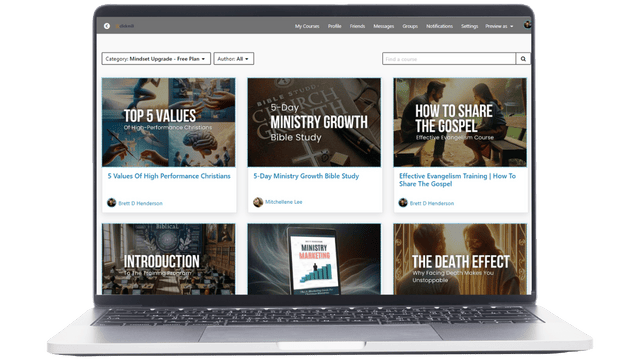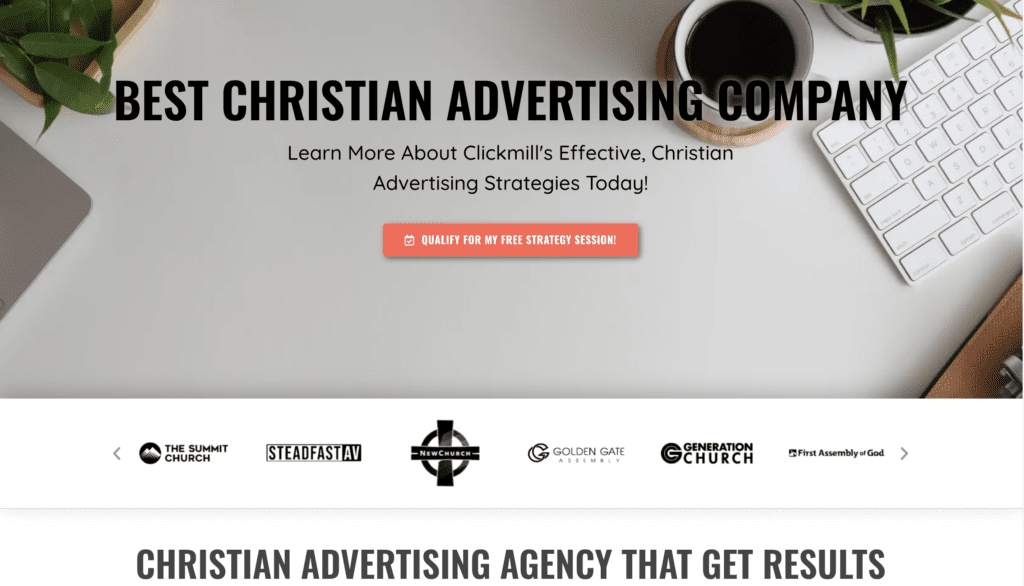Most people would agree that aesthetic appeal is what makes a good church website design. The best church websites are often beautifully designed, and we can all appreciate a site that looks nice.
But what if I told you that aesthetic appeal isn’t the most important factor in determining the success of your website?
Just as there are some beautiful people who are successful and some beautiful people who aren’t, not every beautiful website does well online. Therefore, we cannot say that beauty is the cause of success. Instead, the success of your website is determined by how well it fulfills its purpose.
Unfortunately, many ministry leaders don’t understand the true purpose of their church website.
Do you know the true purpose of your church website?
In this article, we will discuss the true purpose of church websites, and how you can grow your ministry by fulfilling it.
What Is The True Purpose Of Church Website Design?
The true purpose of a church website is to generate conversions.
A conversion occurs when a person enters their contact information into your website, opening the door for you to build a relationship with them in the future.
This is not so different from the church definition of conversion, because just as a person can convert from a non-believer to a believer in Christ, a person can also convert from a passive viewer to an active participant in your ministry. The first step for visitors is to give you their name, email, and/or phone number.

But wait, isn’t the purpose of a church website to grow your church? Shouldn’t the website help bring in new visitors and disciple congregation members?
That is actually the purpose of your overall church marketing strategy.
Many ministry leaders think the goal of their church website is the same as the goal of their marketing strategy. However, the church website is just one part of the church marketing strategy, and it isn’t responsible for the whole thing.
The goal of the church website is just to convert visitors, moving them closer toward the overarching goal of growing the church.
get 4 FREE Online Church Growth courses + 2 Ebooks, & More!
Access 4 Courses, 2 eBooks, Live Group Chat, Live Online Classes & More! Get The Growth God Has For Your Ministry – Get Your Free Account Today!

To understand the importance of this goal, let’s take a look at what happens when you don’t get your visitors’ contact information. If you are unable to convert a visitor before they leave your church website, then you’ve essentially lost the opportunity to make an impact on their lives.
Without their contact information, how will you find them on the internet? The only way you’ll get another opportunity is if they find you again, but there is no guarantee that they’ll come back after they leave.
So how do you convert visitors?
Guiding Visitors Toward Your Website Purpose
Creating a landing page that guides visitors to a targeted call to action will increase your church website’s conversions.
A landing page is a separate section within your church website that doesn’t have all the additional options. It should have as little information as possible so that people don’t get distracted, but just enough information that they don’t get confused. Visitors are sent to a landing page after clicking on your ad, so you’ll want to streamline its design to help visitors quickly understand and take the next step.
This next step is presented in the form of a call to action: a clear, concise request for someone to take a specific action. As shown in the image below, the call to action in our website’s landing page is “qualify for my free strategy session.” Taking that call to action will require visitors to exchange their contact information to claim a block of our time.

To learn how to make a compelling call to action, check out our other article here: Church Marketing Strategy: Get Your Audience To Take Action Now [2022]
Making A Church Website Design With Value
Notice that in the example, value is key.
Instead of begging visitors for their contact information, here at Clickmill, we offer them something of equal value in exchange. That way people aren’t just willing to give us their information–they want to do it–because they want the free strategy session.
Similarly, you should attach value to your call to action to motivate your visitors. You can do this by giving them the opportunity to sign up for a helpful newsletter by providing their name and email, or you can offer to answer all their questions on the phone (collecting their number in the process.)
But how do you know what will be valuable to your audience?
People find value in things that meet their needs.

This doesn’t just apply to urgent physical needs such as the need for food, but it also applies to emotional needs such as the need for entertainment or companionship. There are many types of needs, but the needs you should focus on are the needs of your target audience.
The target audience is the specific group of people that your church has been called to reach. For example, one ministry’s target audience is the low-income families in their community. Understanding the needs of your target audience is important for your ministry as a whole, but it is especially important when it comes to understanding how to create value.
To learn more about finding your target audience, check out our other article here: Building An Effective Ministry: Why You’re Not Connecting With Your Ideal Church Audience
When you have created value and met your target audience’s needs, the Rule of Reciprocity will take effect.
get 4 FREE Online Church Growth courses + 2 Ebooks, & More!
Access 4 Courses, 2 eBooks, Live Group Chat, Live Online Classes & More! Get The Growth God Has For Your Ministry – Get Your Free Account Today!

Reciprocity & Church Website Conversions
The Rule of Reciprocity means that when you genuinely give value to people, they will feel obligated to give back to you. Of course, you shouldn’t give with the expectation of receiving something in return. Some people will just accept the value you brought to them, while others will go above and beyond to repay you for it. You should be prepared for either response, but more often than not, people will lean towards the latter.
We see this in Luke 5, when Jesus first encounters His disciples as they are struggling to fish. The first thing He did was meet their needs, and they wanted to follow Him from that moment onward.
“When He had finished speaking, He said to Simon, “Put out into deep water, and let down the nets for a catch.” Simon answered, “Master, we’ve worked hard all night and haven’t caught anything. But because you say so, I will let down the nets.” When they had done so, they caught such a large number of fish that their nets began to break. So they signaled their partners in the other boat to come and help them, and they came and filled both boats so full that they began to sink.”
“Then Jesus said to Simon, “Don’t be afraid; from now on you will fish for people.” So they pulled their boats up on shore, left everything and followed him.”

In your own church, people will be more likely to convert after you have met their needs with value because of the Rule of Reciprocity. But you shouldn’t cram as much free value as possible into your church website design, because of what I like to call the Discount Vase Theory:
Vases are generally regarded as elegant pieces of decor. When a vase is priced extremely high, people may think that it was made by a famous artist, or that it has exceptional quality. However, when a vase is priced much lower than expected, people begin to wonder if there are any issues with it. Why would a retailer sell something for less than it is usually worth unless there was some kind of defect?
All this goes to show that people understand value through cost.
This means that they are willing to pay for things that they see value in. However, it also means that people tend to overlook the value of things they received for free (or at a low cost) because they didn’t have to pay for it.
Giving people a year’s worth of your Bible studies or a series of your ministry ebooks just to get their contact information is not a good idea, because it conveys the message that even you don’t value those things. Besides, it can be overwhelming for them to receive so much from a church they barely have any connection with yet.
Instead, you should offer people breadcrumbs of value–rather than giving out the whole thing, you could offer them one free trial Bible study, or the first ebook in the series. Each breadcrumb must be valuable in and of itself, because giving out useless pieces of incomplete information will only cause your audience to leave.
When done properly, these breadcrumbs can guide people towards the heart of your ministry, because they must make a higher commitment at each step to receive a larger breadcrumb of value. That’s how you move people from helping reach the purpose of your church website (sharing their contact information) to helping reach the purpose of your ministry (volunteering to help the church fulfill God’s vision).
Church Website Design FAQs
Increase conversions by creating a focused landing page with a clear call to action and offering value in exchange for visitors’ contact information.
An effective church website is designed to fulfill its primary purpose of generating conversions, not just to look aesthetically pleasing.
A landing page is crucial as it guides visitors towards a specific action, like signing up or contacting the church, thereby increasing conversion rates.
Create value by understanding and addressing the needs of your target audience, offering relevant resources or information in exchange for their contact details.
The Rule of Reciprocity in website design implies that providing valuable content or services leads visitors to reciprocate, often by providing their contact information or engaging more deeply with the church.
And that’s about it for this post on the true purpose of church website design: conversions. Once you get your website to fulfill this little-known purpose, you will have more opportunities to grow your ministry.
Let us know in the comments which part you found most informative, so we can write more on it in the future.
And don’t forget to check out our video, which covers this same topic but in greater detail with more examples.
Responses